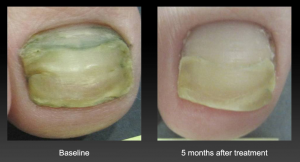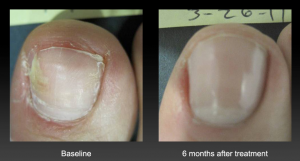Nail fungus, also called onychomycosis, is an infection of the nails which can cause the nails to become yellow, thick, brittle, discolored and sometimes painful. This is a common condition estimated to affect up to 10% of the population.
The infection can be caused by either a fungal or yeast microbe, similar to the same organism which causes Athlete’s foot. This infection thrives in areas that are warm, dark and moist, like shoes and socks.
Onychomycosis resides under the nail itself (in the nail bed) and feeds off of the protein and keratin inside the nail. If the infection spreads to the nail root, it may cause the nail to grow thick and deformed. The infection can also spread to other nails and can cause malodor in the feet. The process is usually pain free until the nail becomes thick or ingrown and then is aggravated by shoe gear pressure. The pain can cause difficulty in ambulation (walking) and affect a person’s day to day activity.
WHAT CAN BE DONE TO TREAT FUNGAL NAILS?
There are several ways of treating fungal nails, the most common being oral, topical medications, and laser treatments.


Oral medications
The medicine enters the blood stream and which in turn travels down to the nail and saturates the nail and nail bed. The medicine will then prevent the new nail that grows in from becoming infected. The process can take six to nine months due to the fact that the toenails grow slowly. The medicine will not clear up the existing infected nails but only allow the new nail growing in to be free of the fungus. After you stop taking the medicine it will still be circulating in your body to allow it to be effective. Blood tests need to be done regularly while taking oral medication to make sure the liver is not being affected.
Topical Medications
Over the counter topicals painted on the nail daily for extended period of time can be effective as well, though results can vary depending on the severity of the fungus.
Laser Treatment
We are very excited to now offer a groundbreaking, effective, and pain-free laser treatment to treat nail fungus!
This brand new, high-tech treatment is painless and side-effect free. It is also the most effective way of treating nail fungus.
In recent clinical trials, 81% of people undergoing laser treatment had moderate to complete clearance of the nail, and 51% were completely clear and tested negative for any fungal infection.
This laser technology is the quickest, easiest, and most effective way to get rid of toenail fungus. Most patients show improvement after only one treatment, though the number of treatments will vary depending on the severely each digit is infected. It can take as little as one session of treatments to clear the nail, and most people will get clarity of the nail after two to three sessions.
A single session takes anywhere between 20 to 40 minutes, depending on the severity of the infection on each toenail. After treatment, the nail will grow out normally within 9-12 months. Below are some images of toenails infected with fungus, and the impressive results after the laser treatment as the nail is growing out.
HOW DOES IT WORK?
The laser beam travels through the nail, under the nail, and to the nail bed to kill the fungus instantly. The laser does not damage the nail or the surrounding skin. Though the laser does not clear the infection instantly, the new nail growth will look healthy as the fungus will be gone. The best part- this is done painlessly! No side effects, no oral medication, and no creams.
HOW IS ONYCHOMYCOSIS DIAGNOSED?
Physical examination and a nail culture will confirm if you have Onychomycosis (a toenail fungal infection). Taking a sample of the nail and sending it to a laboratory will identify the type of fungal infection so that the doctor can manage the correct treatment.
WHY DO I HAVE ONYCHOMYCOSIS?
Nail fungus is quite common in the adult population. There are some statistics stating that as many as 50% of adults over the age of 40 have some kind of nail fungal infection.
The most common type of fungus associated with onychomycosis and Athlete’s foot is called Dermatophyte. Dermatophytes grow in damp, warm, and dark places. They may be present on the skin but will not invade the skin or nail if there is no portal for them to infect. A nail infection usually occurs if there has been a history of injury to the nail, inflammation from an ingrown nail, or cutting the nails incorrectly or too short. Individuals who are medically compromised like patients with peripheral vascular disease, diabetes and HIV are more susceptible.
CAN I PREVENT FROM IT HAPPENING AGAIN?
Yes! Fungus thrives in wet conditions, so clean your shower stall, be careful when you get pedicures, throw out old shoes, and clean all of the socks and shoes that might be contaminated with the fungus. Then control the moisture in your shoes by using a foot powder. Believe it or not, even an under arm antiperspirant will work. Cotton socks or runners socks will help pick up the moisture in your shoes. And finally, trim your nails so that future infections can be prevented.
Call 310.652.3668 to schedule an appointment today.

